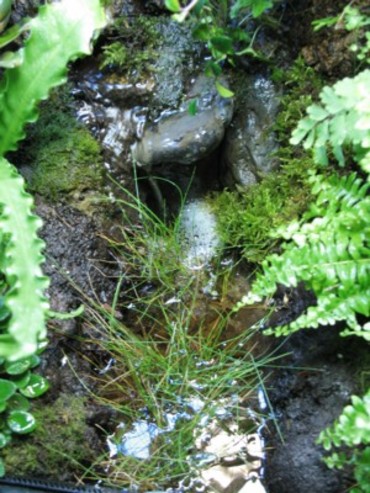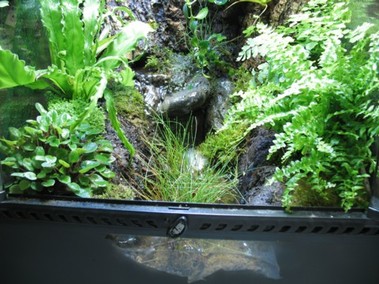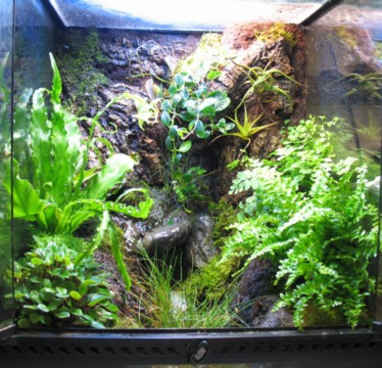Paludarium Build Journal

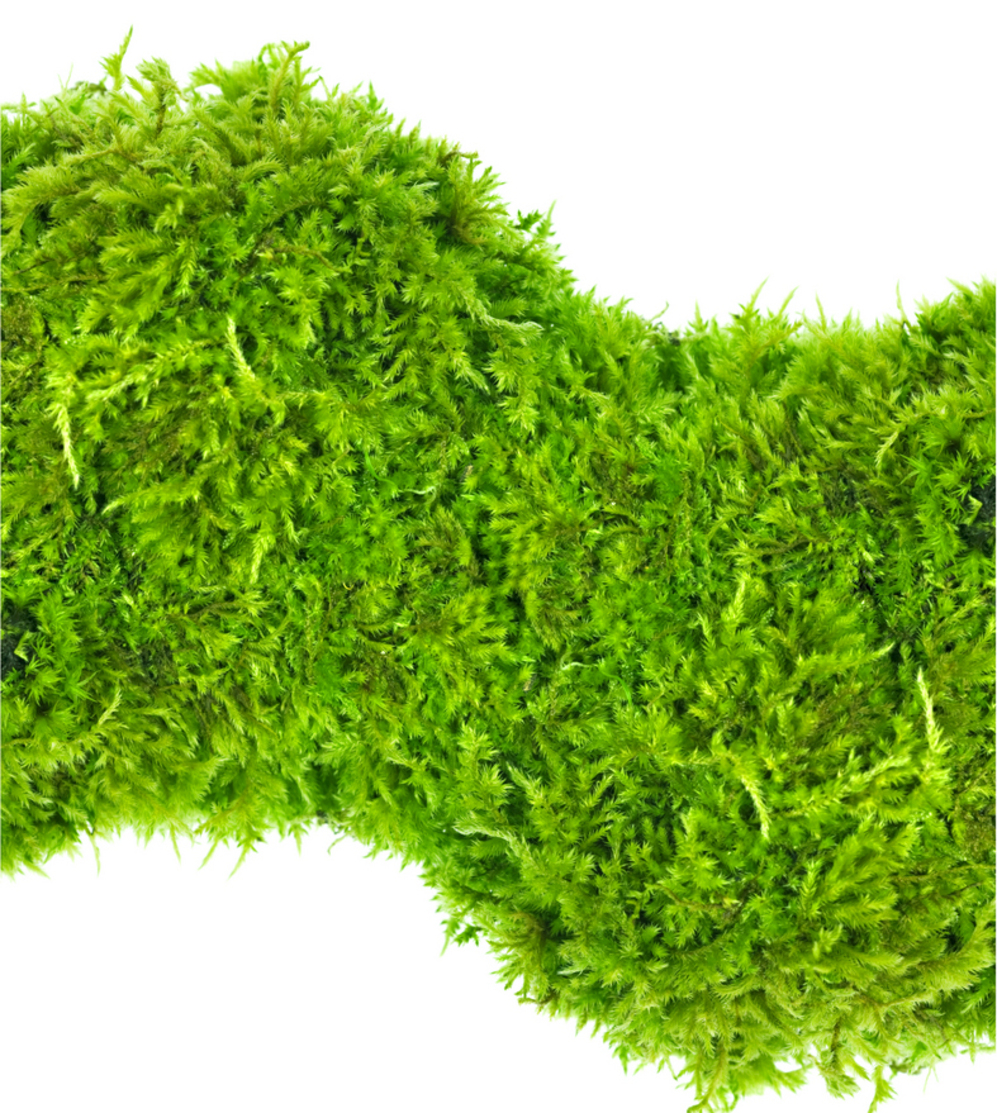
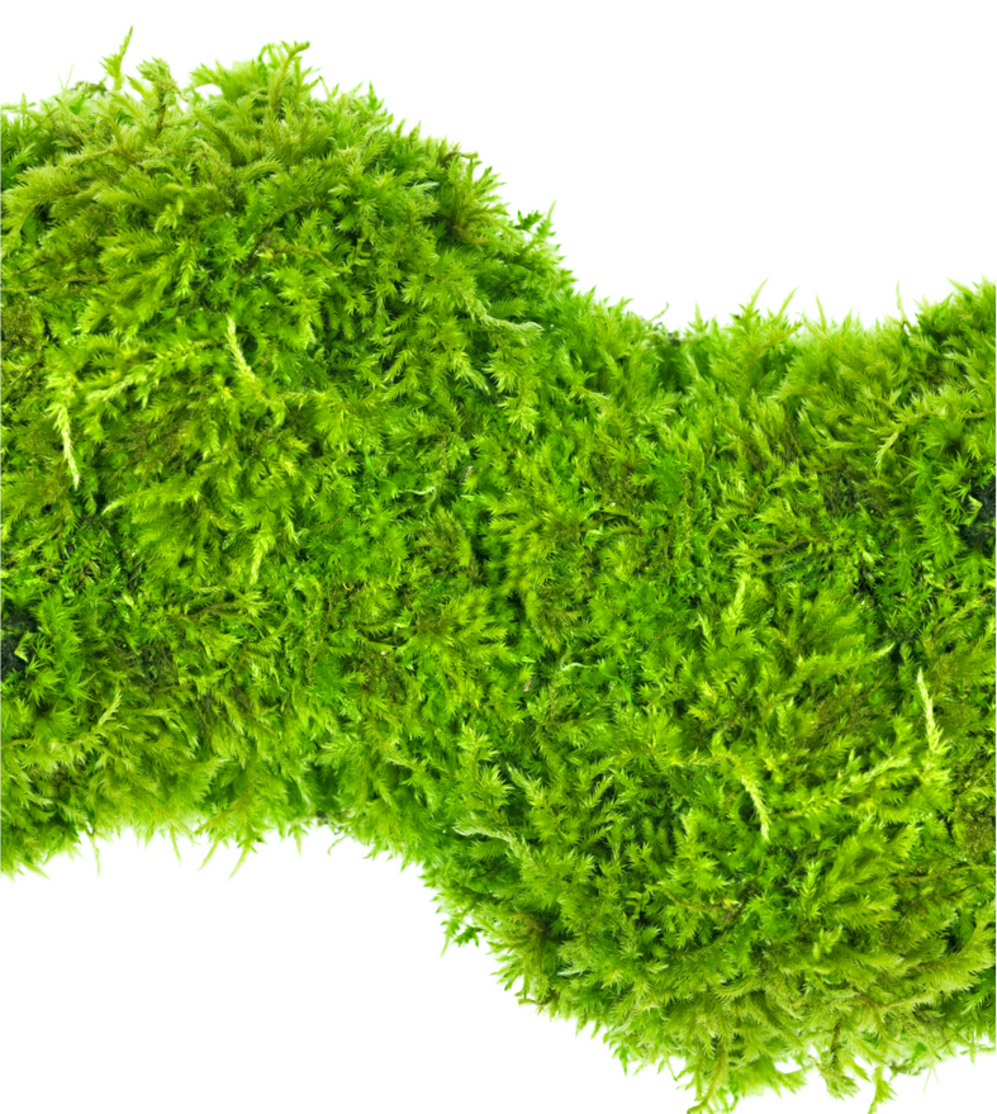

Establishing and Maintaining Water Quality
The main difference between paludarium setups and a typical vivarium is that the water section is usually much larger and is a primary focus of the build. As most want to have clear, non-murky water, a proper filtration system is required. The two best options are building an external sump or go with a canister filter. Canister filters are much easier to work with for the beginning hobbyist as they are typically less expensive than sumps and don't require nearly as much setup. I prefer to use the Cascade series as they are relatively inexpensive as canister filters go and they have on/off valves that make draining/priming easier. Typical aquarium hang on back type filters are very cumbersome with most vivaria designs and I don't recommend them for these kinds of builds.
In order to keep your water crystal clear you will need to perform periodic water changes, just like an aquarium. This will help to remove dissolved solutes in your water as they stay behind when the water evaporates. In many cases large volumes of activated carbon will be needed in your filter. The tea colored tannins leached from wood, peatmoss, and soil will tint your water brown as they build up. The activated carbon will act as a sponge and bind the tannins and other organic acids, trapping them in the filter. The more water movement and carbon you use, the longer the time between water changes. Eventually your carbon will become saturated, and you will need to replace it. What I have found works well is to purchase small granulated aquarium carbon and put it into pantyhose tied off. This will keep it from getting everywhere in your filter, but still allows water to permeate through your media. Be sure to rinse the carbon BEFORE use to prevent it from mucking up your water.
As with any other aquarium, aspects like the nitrogen cycle, pH, TDS, and chlorine removal will need to be properly addressed. In most cases your water pH will be slightly low due to the organic acids from the soil and your nitrate/nitrite levels will be variable depending on the plant/animal/biological filtration volume you have. These aspects can be adjusted by using conventional planted aquarium techniques/products.
Soils
Having the right kind of soil will make a difference in how your system performs. While it is possible to section off the soil from the water, it is very unlikely that this will remain the case throughout the lifetime of your tank, especially with semi-aquatic animals coming in/out of the water. So using a good quality low organic soil can help you keep your water clear.
There are number of different inorganic aquarium plant soils available. The most common commercially available paludarium and planted aquarium soils are small latterite or fluorite clay granules. These clays have a high cation exchange capacity, based on the water pH, and are capable of binding nutrients to themselves. By use of this soil and proper aquatic plant fertilizers you can properly grow your plants without the need of true "soil". There are a number of different products out there, but for the most part they are all about the same, with a few minor differences.
Riparium Supply carries a good quality substrate that works well for these kinds of systems. One advantage of using their product is that it has been washed to help remove the massive amount of colloid particulates that are in these raw soils. It takes me about a half hour worth of washing to remove most of these when I've use unwashed soils. If you don't wash it, the microscopic clay granules will mud up your water like chocolate milk for at least a week.
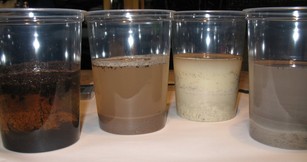
Drilling your tank can make using canister filters easier.



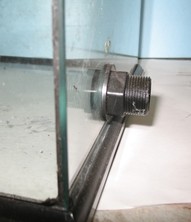
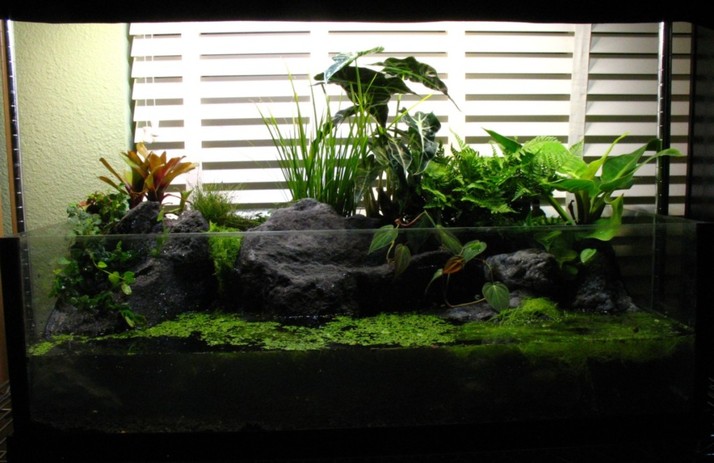
External canister filters help to provide both the pump and filtration volume.
I use large volumes of activated carbon in my paludariums to help reduce the tannin concentration and the tea color they cause.
Eco-Complete planted aquarium substrate works well, requires no washing, and is a dark black color that contrasts well with the plants.
Riparium Supply's paludarium soil works well, also doesn't require washing, and is latterite/fluorite based.
Sphagnum Peatmoss, Topsoil, Sodium Bentonite clay, and River Clay soil. All were mixed with water for soil analysis purposes, but as you can see using normal vivarium soil for paludariums can discolor your water rapidly.
Soil/Water Divider
A common design is to silicone in a divider that sections off organic soil and water compartments. This method while easy, can yield an unsightly divider. Also unless the soil section is drained, it can create an anoxic environment. This can lead to the production of very foul smelling gases as the anaerobic bacteria build up. If a hole and bulkhead is not used to drain water from the soil section, consider allowing water to enter under your soil section.
Since the purpose of the divider is to separate the soil and water, making holes in it would seem to defeat the purpose, however you can fill the area under your soil with LECA or use a falsebottom. The LECA clay aggregate is large enough to allow water movement, is neutral, and is much lighter than using gravel. By allowing water under where your soil is, you will get some solutes leaching into your water as your soil drains. However with proper filtration this will not be an issue. The divider effectively becomes a retaining wall for your LECA/soil and not a watertight barrier, thereby reducing the anaerobic bacteria buildup and subsequent gases. If cut to size and siliconed or foamed in place, the Replica Rocks can be used as a realistic looking divider.
Designs
Submerged Plant Containers
This method is commonly used in ponds however the principle will work in a paludarium as well. The idea is to put soil into a container and grow your plants in them but still allow for water movement. This design works well to contain your soil and allows you to easily move your plants about. Riparium Supply sells both magnetic and suction cup planters designed for this exact purpose. Also the Replica Rocks can be cut and drilled to make realistic rock planters, although these would need to be siliconed in place as they are very buoyant.
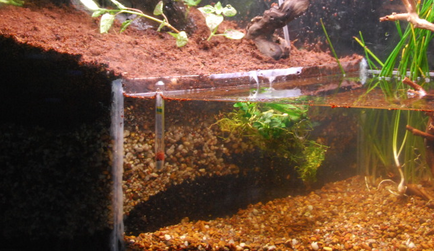
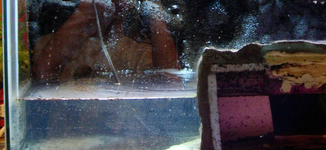
Bulkhead and drain your soil section or let water under it to avoid anoxic gas buildup! The falsebottom on the right held soil that drained into the water below it via small holes.
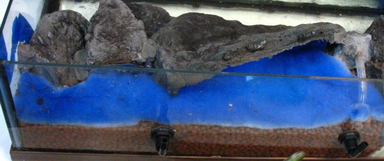
The replica rocks were used to make a divider. Notice the bulkheads and LECA. This allowed plumbing of a canister filter and kept the weight down.
Shelf Container
This is essentially the same design idea as using the planter cups, just on a large scale. By using the Replica Rocks you can design your own size of planter area. The areas in between the rocks or foam can be filled with the expandable polyurethane foam "Great Stuff", which can then be covered with Exhibit:CAST epoxy. It is not recommended that you use the silicone/peat method as the water will quickly erode away the peat from your silicone leaving you with the bare silicone.
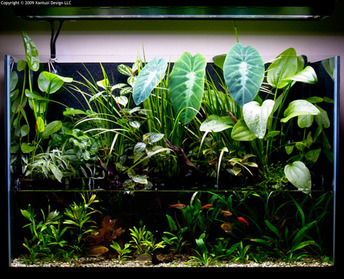
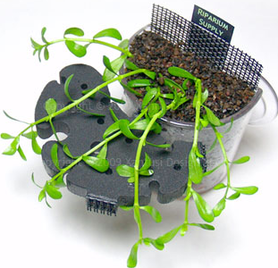
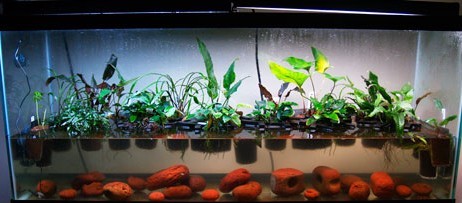
Photos from Riparium Supply.com
Stream
This design involves water moving down a course of rocks and/or tightly compacted soil. Depending on the design, the water can be effectively sectioned off from most of the soil allowing for organic soils use, so long as proper drainage is taken into account. The small rock set replica rocks work well in making this design as they can be piled and foamed together. The spaces in-between can then be filled with the Exhibit:CAST making a semi-water tight stream into your primary water body. A simple pump can be used to run this, however using a canister filter will keep your water cleaner and make water changes and draining much easier.
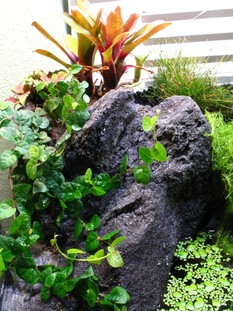
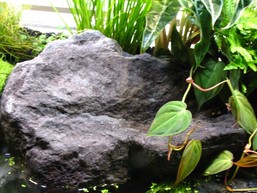
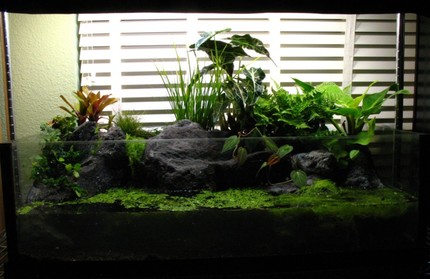
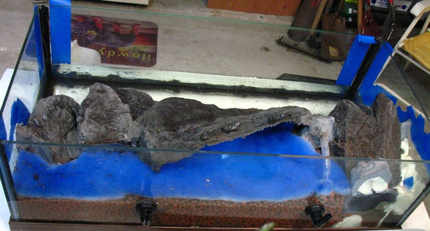
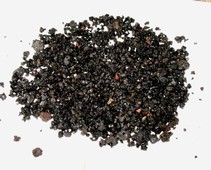
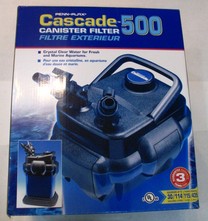
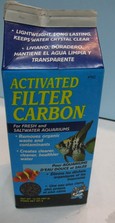
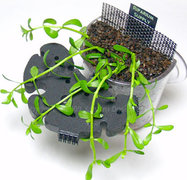
Tips
Keep your animal bioload low to help keep the nitrates in check. Your plants will be absorbing the nitrates, however it can lead to high algae levels if not properly kept in check. Establishing a regular partial water change regimen is a good idea.
I have found that in tank submersible filters don't work well. They simply don't provide enough filtration power to keep the water clear. While they may say they are rated for a certain size aquarium, consider that they make those guidelines based on normal aquariums with plastic plants.
One of the unique aspects about paludariums is that you can grow your plants well outside the confines of your glass aquarium. A 40 breeder aquarium can supply plenty of water volume for many tropical fish, while still allowing you to grow large emergent plants.
Remember that plant tissue respires oxidatively. Yes plants create oxygen during their photosynthetic processes but they also use that oxygen they produce. Meaning that when your lights turn off the plants will be using oxygen just like your fish. Large volumes of plant and algae tissue can quickly absorb all of the dissolved oxygen in your water if not properly kept in check. A good idea is to set an air stone/bubbler to go on during the dark hours of your tank to help ensure your water's dissolved oxygen remains high enough for both your fish AND plants.
Many plants can be grown easily in a hydroponic setup. This is essentially what a paludarium is. A tropical hydroponic garden. So while aquatic and emergent plants are perfect candidates for your design, you can also use many other types of plants.

